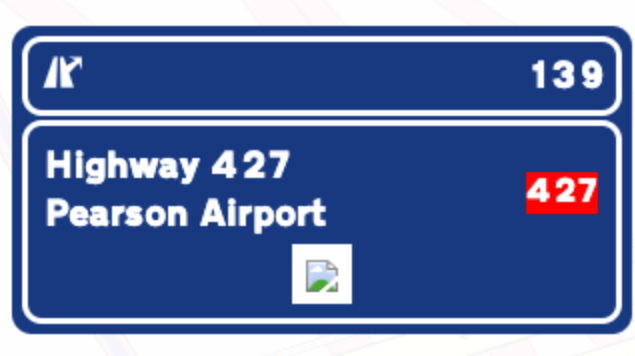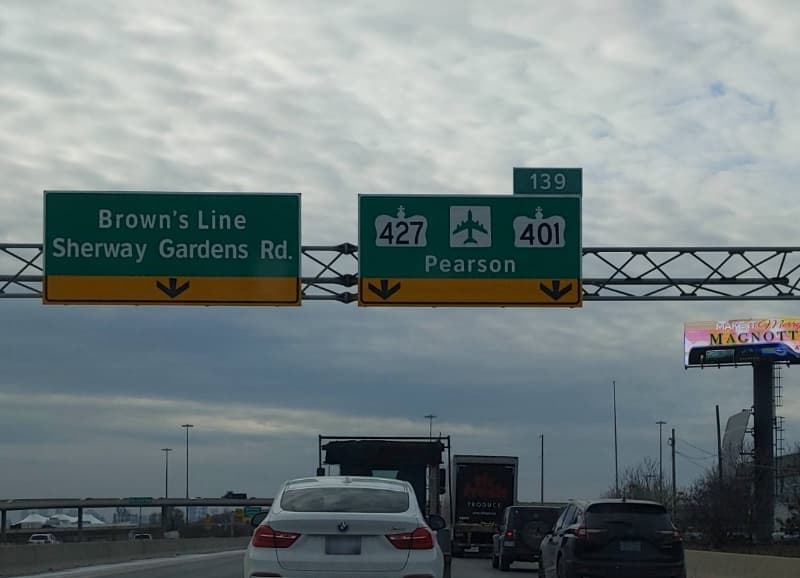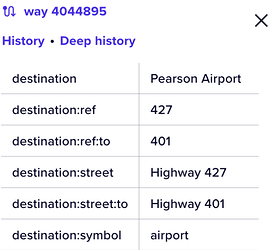Dear Canada community, I’m Artem, a policy lead on the OSM mapping team at Lyft. Due to the broadening of the Destination sign project to Canada, we would like to clarify some questions with the community before launching massive edits.
Tl;dr
- Suggested two approaches of tagging multilingual destinations. First - we put all destinations in both languages in the main tags and add additional tags wih lang code. Second approach - add in the main destination tags only destination in the language that is primary in this area and second language only in lang code
- Is it a good practice in Canada to duplicate values destination:ref in destination or destination:street tags or was it an undiscussed initiative of some mappers?
1. Bilingual destinations
In Canada, we met different types of provinces in terms of Destination Signs languages:
- Only French (i.e. Quebec)
- Only English (i.е. Toronto)
- Bilingual (i.e. Ottawa)
So we want to agree on a tagging schema for Destination Signs in order to support multiple languages and not lose data.
Bilingual signs
The vast majority of bilingual DSs are mapped without any systematic approach.

The English and the French value are mixed for the left direction. But it should be:
In French - Chemin Innes Ouest
In English - Innes Road West

The English and the French value are mixed for the left direction. But it should be:
In French - Promenade Moodie Nord
In English - Moodie Drive North
The French value is ignored
At the same time there are some examples where different languages are put into separate lang:en or lang:fr tags. It also duplicates in the main destination tags in both languages.

Only English/French signs
There is no issue. The values from the sign are added to the main destination tags that looks like a fine decision.
Suggested approach
Bilingual
There are several tags clarifying basic ingested tags in OSM (destination, destination:street and destination:ref)
destination:lang:en
destination:lang:fr
destination:street:lang:en
destination:street:lang:fr
destination:ref:lang:en
destination:ref:lang:fr
So in this case it looks like we have two approaches. Based on the first example from the Bilingual section, let’s look at how we can deal with it.

1st approach:
Firstly, we put all destinations for the right direction into the main destination tag
destination - Chemin Innes Road Est;Innes Road East;Orleans;Orléans;Rockland
Then we add additional language tags
destination:lang:en - Innes Road East;Orleans;Rockland
destination:lang:fr - Chemin Innes Road Est;Orléans;Rockland
As a result, destinations are displayed from lang:en tags for users with EN language in routers and from lang:fr for FR users. If the navigation system doesn’t support language setting, the drivers will see the main destinations in both languages without data loss.
2nd approach:
Firstly, we put all destinations in the language that is primary in this area for the right direction into the main destination tag.
destination - Innes Road East;Orleans;Rockland
And then we add the additional language tags
destination:lang:fr - Chemin Innes Road Est;Orléans;Rockland
As a result, drivers in any language should see the destination from the main tag in primary language in this area and drivers with FR language in routers will see destination with lang:fr with correct guidance and banners. But in this case, we lose data in the French language in the main destination tag. It’s not a good point, for the navigation system, that doesn’t support language settings.
Single language
Signs with English or French value only are applied to the main destination tags (destination, destination:street or destination:ref).
2. Duplicating destination:ref info in destination and destination:street
We came across several cases where destination:ref value was duplicated into the destination/street tag, without any indicators on the destination sign.
This info looks as duplicated and causes a duplicated guidance suggestion in the routers, and banners.

Toward 401/Highway 401

On the banner Highway 427 as a destination and as destination:ref
Is it a good practice in Canada to duplicate destination:ref in such ways, or was it an undiscussed initiative of some mappers, and can we clean up such duplicates?
Our goal is to reach a consensus and avoid any potential conflicts. Your thoughts and insights are invaluable in this process.
Thanks in advance for your cooperation and suggestions.


